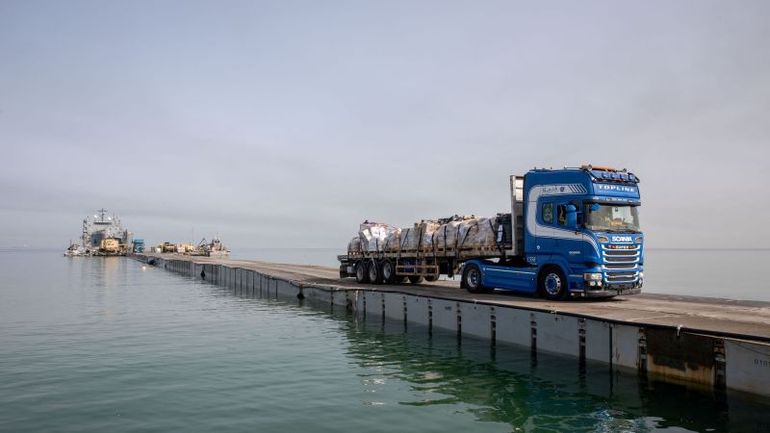
Humanitarian Aid Arrives in Gaza Through US Pier and Begins Distribution Despite Challenges

Aid organizations have started distributing the humanitarian aid unloaded at the US-built pier in Gaza to help Palestinians, overcoming hurdles such as disruptions from Hamas drones and incidents of looting that caused delays in the delivery process.
Aid groups have started distributing the humanitarian assistance from the US pier in Gaza to Palestinians. They faced challenges like Hamas drones and looting along the distribution routes, causing delays.
A top official from the US Agency for International Development (USAID) mentioned that over 500 metric tons of food and aid have been offloaded at the pier. Two-thirds of this aid has been given to humanitarian partners or is on its way to those in need.
The US military's pier operation faced challenges in distributing aid to Gaza after a rocky start. Vice Admiral Brad Cooper, the deputy commander of United States Central Command, reported that aid deliveries were delayed due to a Hamas drone attack on the IDF near the pier. Additionally, some trucks were looted along the distribution path earlier in the week, causing further disruptions.
The US military had to assist USAID in finding safer routes for trucks leaving the beach area near the pier and heading to the warehouses. These challenges in internal distribution are common in aid delivery from the sea, according to Cooper. It gives a glimpse into the operating environment.
Over the past two months, more than 1,000 US troops worked on constructing a humanitarian pier and causeway off the coast of Gaza. The operation officially started last week. However, as of Tuesday, the Pentagon reported that none of the aid unloaded from the pier had reached the wider Palestinian population.
Officials have highlighted that the maritime corridor is intended to support the land crossings into Gaza, which are often closed or slowed down by Israeli inspections. Additionally, the US military will keep providing aid to Gaza through airdrops, as confirmed by Cooper.
Daniel Dieckhaus, director for USAID’s Levant Response Management Team, mentioned that the aid provided can feed tens of thousands of people for a month.
The situation in Gaza is extremely serious, with the entire population struggling to access enough food and some areas already suffering from famine. In addition, there is a shortage of fuel, which is crucial for aid organizations to deliver the necessary support.
Dieckhaus clarified that the pier was never meant to replace any border crossing, but rather to complement existing routes. He emphasized this point during the call.
According to a recent update from USAID, on Wednesday, 27 trucks carrying over 185 metric tons of aid departed from the marshaling area in Gaza for distribution. Dieckhaus also mentioned that there is a substantial amount of aid, totaling "thousands and thousands of tons," in Cyprus awaiting processing before being transported through the pier.
Some land crossings into Gaza are still open. According to USAID, on Wednesday, there were 215 private sector trucks entering Gaza through Kerem Shalom and 115 humanitarian assistance trucks through Zikim/Erez West.
However, Rafah and Erez East are still closed, leading to a dire humanitarian situation in the area.
We are collaborating with humanitarian partners to increase and maintain vital aid to address the increasing humanitarian needs in Gaza. There is still a lot more that needs to be accomplished to save lives and reduce the extensive suffering of civilians in Gaza. The United States is committed to continuing our work to provide more assistance through various channels.
Additionally, on Thursday, Cooper informed reporters that three US service members had suffered non-combat-related injuries during the pier mission.
Two US troops were taken to a local Israeli hospital with minor injuries — a sprained ankle and injured back, Cooper said, describing them as “routine injuries.” They have since returned to duty.
A US defense official said Thursday that another service member is in critical condition after being injured while working aboard the USNS Benavidez in support of the mission. The critically injured service member was also taken to a medical facility in Israel.
Editor's P/S:
The humanitarian crisis in Gaza is a heartbreaking reality, and the challenges faced by aid groups in distributing assistance are deeply troubling. The delays caused by Hamas drones and looting highlight the volatile and dangerous operating environment in the region. It is imperative that all parties involved prioritize the safety and well-being of civilians and ensure that aid reaches those in desperate need.
The construction of the humanitarian pier and causeway by US troops is a commendable effort to alleviate the suffering in Gaza. However, it is crucial that this initiative is complemented by other measures to address the underlying causes of the crisis. The closure of certain land crossings into Gaza and the ongoing fuel shortage continue to exacerbate the situation, making it essential for the international community to work together to find sustainable solutions that will bring lasting relief to the Palestinian people.






